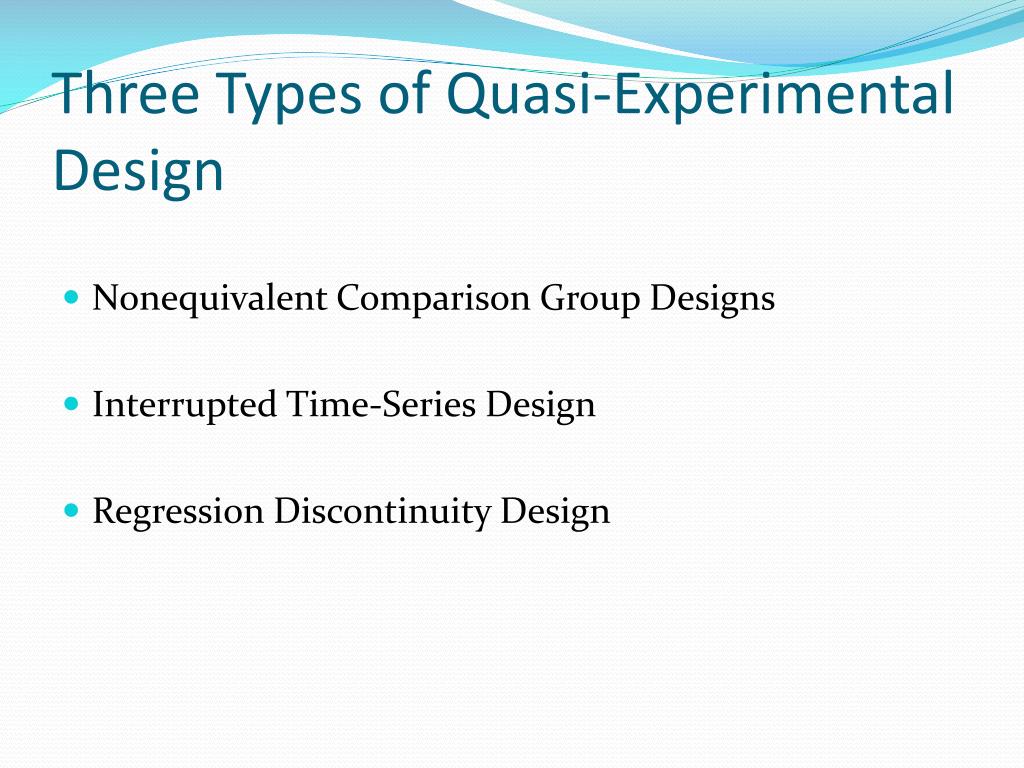Table Of Content

As a result, differences between groups on both observed and unobserved characteristics would be due to chance, rather than to a systematic factor related to treatment (e.g., illness severity). In the four-year period of JAMIA publications that the authors reviewed, 25 quasi-experimental studies among 22 articles were published. Of these 25, 15 studies were of category A, five studies were of category B, two studies were of category C, and no studies were of category D. Although there were no studies of category D (interrupted time-series analyses), three of the studies classified as category A had data collected that could have been analyzed as an interrupted time-series analysis.
Regression discontinuity
We also review the use of quasi-experimental designs in implementation science, and discuss the strengths and weaknesses of these approaches. Randomized controlled trials (RCTs) in which individuals are assigned to intervention or control (standard-of-care or placebo) arms are considered the gold standard for assessing causality and as such are a first choice for most intervention research. Random allocation minimizes selection bias and maximizes the likelihood that measured and unmeasured confounding variables are distributed equally, enabling any difference in outcomes between intervention and control arms to be attributed to the intervention under study. RCTs can also involve random assignment of groups (e.g., clinics, worksites or communities) to intervention and control arms, but a large number of groups are required in order to realize the full benefits of randomization.
What are the different quasi-experimental study designs?
Regression to the mean can be a problem when participants are selected for further study because of their extreme scores. A closely related concept—and an extremely important one in psychological research—is spontaneous remission. In reviewing the results of several studies of treatments for depression, researchers Michael Posternak and Ivan Miller found that participants in waitlist control conditions improved an average of 10 to 15% before they received any treatment at all (Posternak & Miller, 2001).
Experimental and Quasi-Experimental Designs in Implementation Research

In the example of a pharmacy order-entry system, O1 through O5 could represent monthly pharmacy costs preintervention and O6 through O10 monthly pharmacy costs post the introduction of the pharmacy order-entry system. Interrupted time-series designs also can be further strengthened by incorporating many of the design features previously mentioned in other categories (such as removal of the treatment, inclusion of a nondependent outcome variable, or the addition of a control group). Finally, if participants in this kind of design are randomly assigned to conditions, it becomes a true experiment rather than a quasi experiment. In fact, it is the kind of experiment that Eysenck called for—and that has now been conducted many times—to demonstrate the effectiveness of psychotherapy. In this design, all subjects receive the new PDA-based order entry system and the old computer terminal-based order entry system.

Consequently, if there is adequate examination of characteristics of participants and setting-related factors it can be possible to interpret findings among critical groups for which there may be no existing evidence of an intervention effect for. For example in the Campus Watch intervention (16), the investigator over-sampled the Maori indigenous population in order to be able to stratify the results and investigate whether the program was effective for this under-studied group. In the study by Zombré et al (52) on health care access in Burkina Faso, the authors examined clinic density characteristics to determine its impact on sustainability. Table 2 provides examples of studies using SWD that have used one or more of the design approaches described above to improve the internal validity of the study.
External Validity
Perhaps an antidrug program aired on television and many of the students watched it, or perhaps a celebrity died of a drug overdose and many of the students heard about it. Participants might have changed between the pretest and the posttest in ways that they were going to anyway because they are growing and learning. If it were a yearlong program, participants might become less impulsive or better reasoners and this might be responsible for the change. The Behavioral Health Interdisciplinary Program (BHIP) Enhancement Project is a recent example of a stepped-wedge implementation trial (Bauer et al., 2016; Bauer et al., 2019). Figure 2 illustrates the implementation and stepdown periods for that trial, with black dots representing primary data collection points. One of the strengths of QEDs is that they are often employed to examine intervention effects in real world settings and often, for more diverse populations and settings.
Discontinuity in regression
Impact of the Momentum pilot project on male involvement in maternal health and newborn care in Kinshasa ... - BioMed Central
Impact of the Momentum pilot project on male involvement in maternal health and newborn care in Kinshasa ....
Posted: Fri, 18 Nov 2022 08:00:00 GMT [source]
Quasi-experimental designs are used when researchers don’t want to use randomization when evaluating their intervention. A quasi-experimental design allows researchers to take advantage of previously collected data and use it in their study. Researchers interested in studying the impact of a public health campaign aimed at reducing smoking rates may take advantage of a natural experiment. By comparing smoking rates in a region that has implemented the campaign to a similar region that has not, researchers can examine the effectiveness of the intervention. These quasi-experimental designs offer researchers flexible alternatives to traditional experiments, allowing exploration of cause-and-effect relationships in various contexts. In order to assure subject safety, all researchers should have their project reviewed by the Institutional Review Boards (IRBS).
While two-arm RCTs can be used to evaluate comparative effectiveness, trials focused on optimizing implementation support may use alternative experimental designs (Collins et al., 2005; Collins et al., 2007). For example, in certain clinical contexts, multi-component “bundles” of implementation strategies may be warranted (e.g. a bundle consisting of clinician training, technical assistance, and audit/feedback to encourage clinicians to use a new evidence-based practice). In these situations, implementation researchers might consider using factorial or fractional-factorial designs. Such designs can be particularly useful in informing multi-component implementation strategies that are not redundant or overly burdensome (Collins et al., 2014a; Collins et al., 2009; Collins et al., 2007). As well, when a complex intervention is related to a policy or guideline shift and implementation requires logistical adjustments (such as phased roll-outs to embed the intervention or to train staff), QEDs more truly mimic real world constraints. As a result, capturing processes of implementation are critical as they can describe important variation in uptake, informing interpretation of the findings for external validity.
Experiments and Quasi-Experiments
In the study by Killam et al 2010 (31), a non-randomized SWD was used to evaluate a complex clinic-based intervention for integrating anti-retro viral (ART) treatment into routine antenatal care in Zambia for post-partum women. The design involved matching clinics by size and an inverse roll-out, to balance out the sizes across the four groups. The inverse roll-out involved four strata of clinics, grouped by size with two clinics in each strata. The roll-out was sequenced across these eight clinics, such that one smaller clinics began earlier, with three clinics of increasing size getting the intervention afterwards. This was then followed by a descending order of clinics by size for the remaining roll-out, ending with the smallest clinic.
They might hypothesize that the provision of government-subsidized child care would promote such employment. They could then design an experiment in which some subjects would be provided the option of government-funded child care subsidies and others would not. The researchers might also manipulate the value of the child care subsidies in order to determine if higher subsidy values might result in different levels of maternal employment.
Even if sites are randomized, however, early and late wave sites may still differ on important characteristics such as size, rurality, and case mix. The resulting confounding between site assignment and time can threaten the internal validity of the study—although, as above, balancing algorithms can reduce this risk. Third, the use of formative evaluation (Elwy, this issue), while useful for maximizing the utility of implementation efforts in a stepped wedge, can mean that late-wave sites receive different implementation strategies than early-wave sites. Similarly, formative evaluation may inform midstream adaptations to the clinical innovation being implemented. Overall, then, stepped wedges represent useful tools for evaluating the impact of health interventions that (as with all designs) are subject to certain weaknesses and limitations. Internal validity is defined as the degree to which observed changes in outcomes can be correctly inferred to be caused by an exposure or an intervention.
Quasi-experiments are most likely to be conducted in field settings in which random assignment is difficult or impossible. They are often conducted to evaluate the effectiveness of a treatment—perhaps a type of psychotherapy or an educational intervention. There are many different kinds of quasi-experiments, but we will discuss just a few of the most common ones here. In situations where it is known that only a small sample size will be available to test the efficacy of an intervention, randomization may not be a viable option.
Let’s explore a few examples of quasi-experimental designs to understand their application in different contexts. Its objective is to equalize the 2 groups, and therefore, any observed difference in the study outcome afterwards will only be attributed to the intervention – i.e. it removes confounding. If any substantial variations between them can be well explained, you may be very assured that any differences are attributable to the treatment but not to other extraneous variables. In a genuine trial, you’d split half of the psych ward into treatment groups, With half getting the new psychotherapy therapy and the other half receiving standard depression treatment. As a result, in terms of internal consistency, quasi-experiments fall somewhere between correlational research and actual experiments. A hypothetical quasi-experimental study was conducted in an economically developing country in a mid-sized city.
However, as research methods have become more rigorous, and the problems with generalizing from a convenience sample to the larger population have become more apparent, experimental researchers are increasingly turning to random sampling. In experimental policy research studies, participants are often randomly selected from program administrative databases and randomly assigned to the control or treatment groups. A type of quasi-experimental design that is generally better than either the nonequivalent groups design or the pretest-posttest design is one that combines elements of both. There is a treatment group that is given a pretest, receives a treatment, and then is given a posttest. But at the same time there is a control group that is given a pretest, does not receive the treatment, and then is given a posttest. The question, then, is not simply whether participants who receive the treatment improve but whether they improve more than participants who do not receive the treatment.

No comments:
Post a Comment